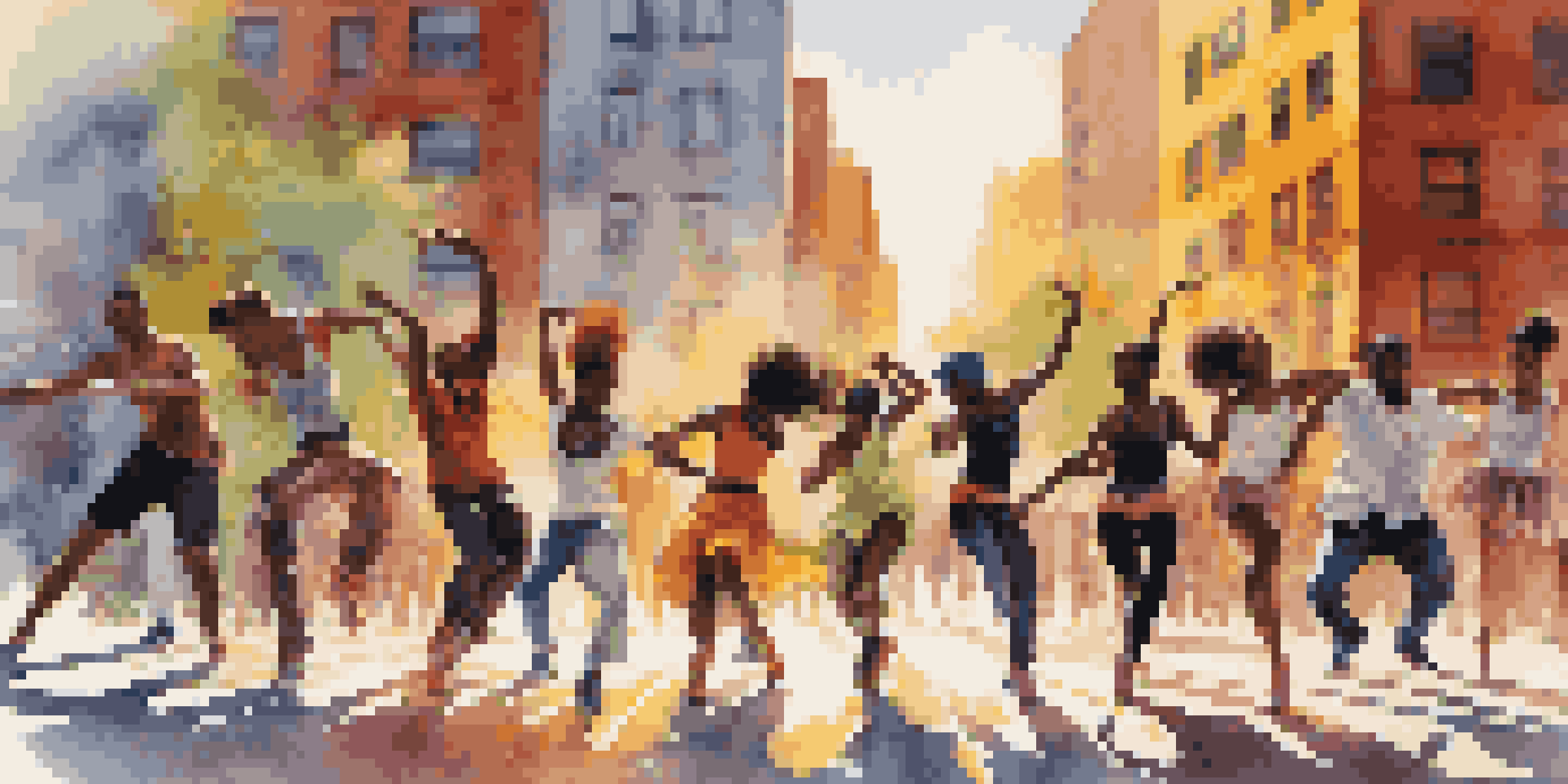Global Dance Trends: The Role of YouTube and Digital Platforms

The Evolution of Dance in the Digital Age
Dance has always been a form of expression, but the rise of digital platforms has transformed its landscape. In the past, sharing dance moves was limited to local communities, but now, anyone with an internet connection can showcase their talent. This evolution has not only democratized dance but also allowed for a diverse range of styles to flourish globally.
Dance is the hidden language of the soul.
YouTube, as a leading video-sharing platform, has played a pivotal role in this transformation. Dancers from every corner of the world can upload their routines, making it easier for others to learn, adapt, and innovate. This accessibility means that dance styles can spread like wildfire, leading to a rich tapestry of global influences.
Moreover, social media platforms like Instagram and TikTok have further accelerated this trend. These platforms encourage short, engaging clips that can go viral, inspiring countless others to join in and create their interpretations. This interconnectedness fosters a vibrant community where creativity knows no bounds.
YouTube as a Dance Learning Hub
YouTube has become a go-to resource for aspiring dancers looking to learn new styles or perfect their technique. With countless tutorial videos available, anyone can follow along and master moves at their own pace. This self-paced learning environment empowers individuals to explore diverse dance forms, from hip-hop to ballet.

Many professional dancers and choreographers have taken to YouTube to share their expertise, offering insights that traditional dance classes might not provide. This includes everything from warm-up routines to advanced choreography. The ability to access high-quality instruction from the comfort of one's home is a game-changer for many.
Digital Platforms Transform Dance
The rise of digital platforms has democratized dance, allowing diverse styles to flourish globally.
Additionally, the community aspect of YouTube allows for interaction and feedback. Dancers can share their progress, receive constructive criticism, and even collaborate with others online. This sense of belonging fosters a supportive environment where learners can thrive.
The Impact of Viral Dances on Global Culture
Viral dance challenges have taken the internet by storm, with platforms like TikTok leading the charge. These challenges often originate from a single video and quickly spread, inspiring millions to replicate the moves. This phenomenon not only popularizes specific dances but also brings attention to the cultural roots behind them.
The dance is a poem of which each movement is a word.
Take the 'Renegade' dance, for example; it started with a young dancer and exploded into a worldwide sensation. Such trends highlight how quickly dance can transcend borders, connecting people through shared movement and creativity. The influence of viral dances often reaches beyond the dance floor, impacting music charts and pop culture.
Moreover, these viral moments showcase the creativity of everyday dancers, not just professionals. It empowers individuals to contribute to the global dance narrative, ensuring that diverse voices and styles are recognized. The ripple effect of these trends can lead to new collaborations and opportunities for dancers around the world.
Digital Platforms and Dance Collaboration
Collaboration has always been a key element of dance, and digital platforms have made it easier than ever. Dancers from different parts of the world can connect and create together, regardless of geographical barriers. This has led to unique fusion styles that combine elements from various cultures.
YouTube and other platforms allow dancers to share their collaborative projects, showcasing the beauty of diversity in dance. For instance, a hip-hop dancer from New York might collaborate with a traditional Bharatanatyam dancer from India, creating a mesmerizing blend of styles. These collaborations can inspire new movements and broaden the horizons of what dance can be.
YouTube as a Learning Resource
YouTube serves as a valuable hub for aspiring dancers, offering countless tutorials and a supportive community.
Furthermore, digital collaboration tools enable real-time interaction, making it possible for dancers to rehearse and create together from afar. This virtual connectivity fosters innovation and helps dancers push the limits of their creativity, resulting in exciting new performances.
The Role of Influencers in Dance Trends
Influencers have become pivotal in shaping dance trends on platforms like YouTube and TikTok. These individuals often have large followings, and their dance videos can spark new challenges or revive old styles. By showcasing their talent, they inspire their audiences to engage with dance, whether by learning or simply appreciating it.
Many influencers partner with brands, further promoting dance culture through sponsored content. This collaboration can introduce dance to new audiences, fostering greater appreciation for the art form. As influencers continue to shape trends, they play a critical role in the ongoing evolution of dance in the digital age.
Moreover, these influencers often share their personal journeys, making dance more relatable. Their stories resonate with viewers, encouraging them to explore their own passions. This connection helps cultivate a community where everyone feels welcome, regardless of their skill level.
Challenges of Digital Dance Culture
While digital platforms have transformed dance, they also present challenges. The pressure to create viral content can overshadow the artistic expression that dance embodies. Dancers may feel compelled to prioritize trends over their personal style, leading to a homogenization of movement.
Additionally, the accessibility of dance tutorials means that not all content is created equal. Some tutorials may lack proper technique or guidance, which can lead to injuries or bad habits. It's essential for dancers, especially beginners, to seek out reputable sources to ensure they are learning correctly.
Viral Dances Shape Culture
Viral dance challenges on platforms like TikTok not only popularize specific moves but also connect people through shared creativity.
Lastly, the rapid pace of trends can be exhausting. Dancers may feel the need to constantly keep up with new styles and challenges, which can lead to burnout. It's important for artists to find a balance between participating in trends and nurturing their own unique voice.
The Future of Dance in a Digital World
As we look ahead, the future of dance in a digital world appears bright. Technology continues to evolve, offering new tools and platforms for dancers to explore. Virtual reality, for instance, could change how we learn and experience dance, allowing for immersive environments that enhance creativity.
Moreover, the ongoing popularity of streaming services has opened up new avenues for dance performances. Dancers can now showcase their work to a global audience, breaking down the traditional barriers of performance art. This exposure can lead to greater recognition and opportunities for artists worldwide.

Ultimately, the fusion of dance and digital platforms will continue to shape the art form. As technology advances and new trends emerge, dancers will have the tools to innovate and inspire. The global dance community will thrive as it embraces the endless possibilities that the digital age offers.